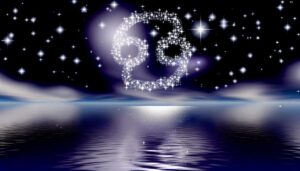Deciphering the Meaning of the Female Symbol with Horns
The female symbol with horns, steeped in ancient civilizations like Mesopotamia and Egypt, signifies a complex narrative of fertility, power, and transformation. This emblem, seen in goddesses such as Hathor and Artemis, reflects dualities like creation and destruction.
Through various cultural lenses, it represents independence, strength, and a connection to nature. In contemporary contexts, it serves as a powerful icon of feminist empowerment, challenging patriarchal norms and symbolizing multifaceted identities.
This symbol also permeates modern pop culture, art, and psychological discourse, emphasizing the intricate interplay between identity, power, and societal expectations. Explore further to unfold its deeper meanings and global variations.
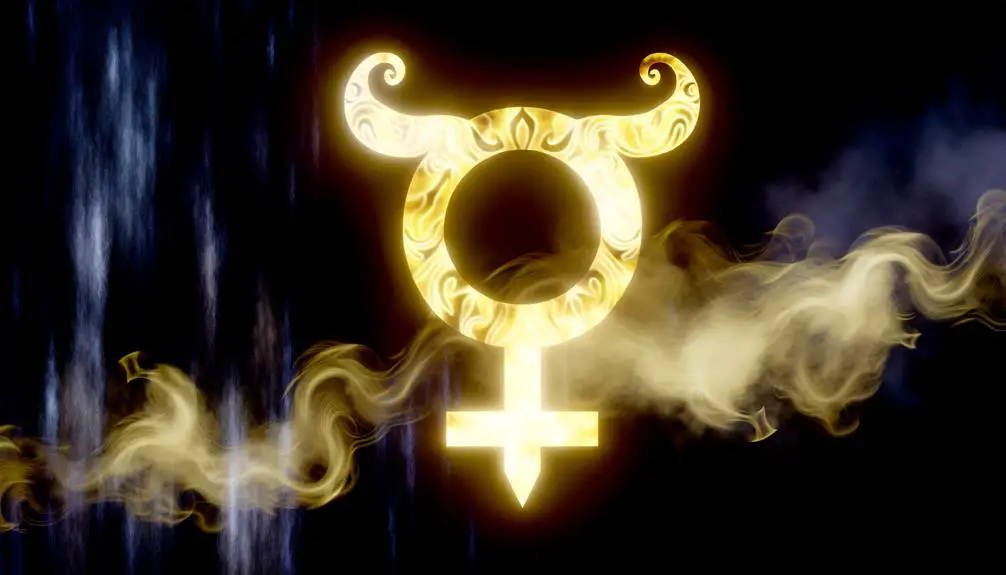
Key Takeaways
- Represents fertility, power, transformation, and mysticism rooted in ancient civilizations.
- Symbolizes female empowerment, independence, and strength, challenging traditional gender roles.
- Reflects dualities like creation and destruction, wisdom and wildness.
- Used in modern pop culture to signify defiance and multifaceted female identities.
- Interpreted through diverse cultural lenses, representing feminine power and connection to nature.
Historical Origins
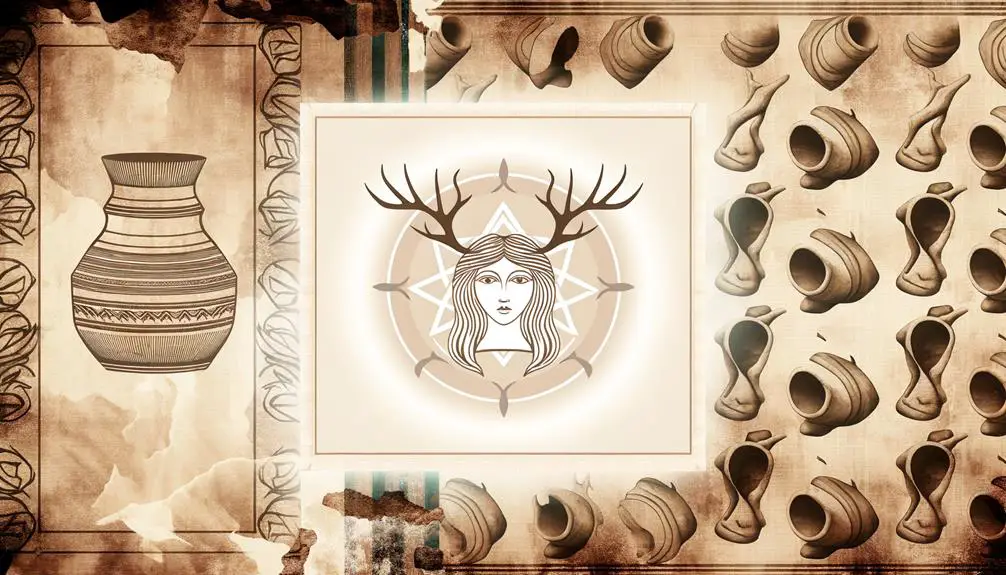
The symbol of the female with horns, often associated with various mythological and cultural contexts, has its historical origins rooted in ancient civilizations where it was imbued with diverse meanings and significances.
In Mesopotamia, such imagery was linked to deities like Inanna, representing fertility and power. Similarly, in ancient Egypt, the goddess Hathor was depicted with cow horns, symbolizing motherhood and celestial domains.
In Greek antiquity, this motif appeared in depictions of goddesses like Artemis, signifying wild nature and lunar cycles. These representations reflected societal values and cosmological understandings, encapsulating attributes such as fertility, protection, and divine authority.
Through these early civilizations, the horned female figure emerged as a potent symbol, intricately woven into the fabric of cultural narratives.
Mythological Significance
Building on these historical origins, mythological significance further expands the symbolic interpretations of the female figure with horns, embedding her within narratives that highlight themes of power, transformation, and the mystical interplay between humanity and the divine. This figure often embodies dualities such as creation and destruction, wisdom and wildness. Ancient myths from diverse cultures frequently feature horned goddesses or female spirits, each representing unique aspects of the natural and supernatural worlds.
| Culture | Deity/Goddess | Significance |
|---|---|---|
| Greek | Artemis | Protector of wildlife and the hunt |
| Mesopotamian | Inanna/Ishtar | Symbol of love, war, and fertility |
| Celtic | Cernunnos (female aspects) | Connection to nature, fertility, and rebirth |
These mythological figures underscore the complex, multi-faceted nature of the horned female symbol.
Cultural Interpretations
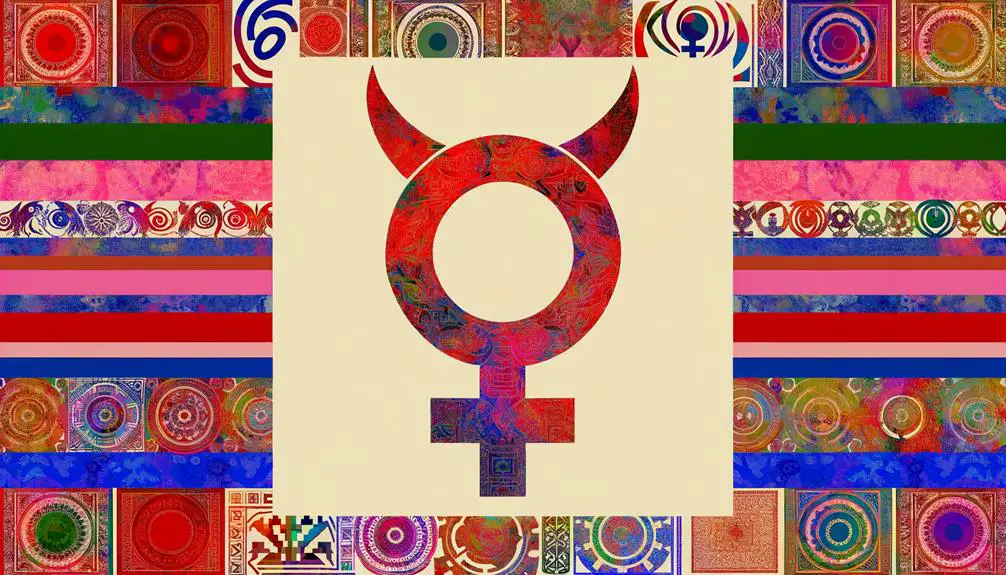
Across different cultures, the female symbol with horns is interpreted through various lenses, reflecting diverse societal values, spiritual beliefs, and historical contexts.
In ancient Egyptian culture, Hathor, the goddess of motherhood and fertility, was often depicted with cow horns, symbolizing nurturing and protection.
In contrast, Greek mythology presents the female horned figure as a representation of power and independence, as seen in the Minotaur's lineage through Pasiphaë.
Similarly, in Celtic traditions, horned goddesses like Epona embody strength and connection to nature.
Consider the following interpretations:
- Egyptian: Nurturing and protection.
- Greek: Power and independence.
- Celtic: Strength and nature.
These varied cultural lenses underscore the symbol's multifaceted significance, resonating with each society's unique ethos.
Symbolism in Art
The depiction of the female symbol with horns in art has undergone significant evolution, mirroring shifts in cultural interpretations and societal values.
Historically, this symbol was often utilized to represent goddesses and feminine power, imbuing artworks with layers of meaning related to fertility, authority, and mysticism.
As artistic representations have progressed, the horned female symbol has adapted, continually reflecting the dynamic nature of feminine strength and empowerment.
Historical Artistic Representations
Throughout history, artistic representations of the female symbol with horns have served as powerful metaphors reflecting societal attitudes, mythological narratives, and cultural values. This imagery has appeared in various forms, highlighting its significance in different epochs:
Ancient Egypt: Goddess Hathor, depicted with cow horns, symbolized motherhood, music, and fertility.
Classical Greece: The goddess Io, transformed into a heifer, had horns signifying transformation and divine interaction.
Medieval Europe: Artistic portrayals of witches with horns often symbolized rebellion and feared otherness.
These representations underscore the multifaceted roles women occupied in mythology and society. By analyzing such symbols, one can discern the evolving perceptions of femininity, power, and mysticism across different cultural landscapes.
Cultural Interpretations Evolved
As artistic representations of the female symbol with horns progressed through history, their cultural interpretations evolved, reflecting shifts in societal values and artistic paradigms. Initially imbued with mystical and religious connotations, these symbols evolved into expressions of rebellion and empowerment in modern art. This transformation highlights the fluidity of symbols within evolving cultural contexts.
| Era | Interpretation |
|---|---|
| Ancient | Mystical, Divine |
| Medieval | Sinister, Demonic |
| Contemporary | Empowerment, Rebellion |
The ancient era revered the horned female as a divine entity, often linked to goddesses. In contrast, the medieval period demonized such symbols, associating them with witchcraft. Contemporary art, however, reclaims the symbol, celebrating it as a potent emblem of female strength and autonomy. This dynamic evolution underscores how art mirrors societal change.
Feminine Power Depiction
Frequently depicted in contemporary art, the horned female symbol serves as a powerful narrative device to explore themes of feminine strength and autonomy. This emblem often challenges traditional gender norms, portraying women as both nurturing and formidable. Artists leverage this iconography to highlight the multifaceted nature of female power, blending vulnerability with resilience.
Key aspects of this depiction include:
- Empowerment: Horns signify authority and leadership, reinforcing women's capability to command and protect.
- Duality: The juxtaposition of feminine and aggressive traits underscores the complexity of identity.
- Mythology: Drawing from ancient myths, such representations connect modern interpretations with historical reverence for female deities.
Feminist Perspectives
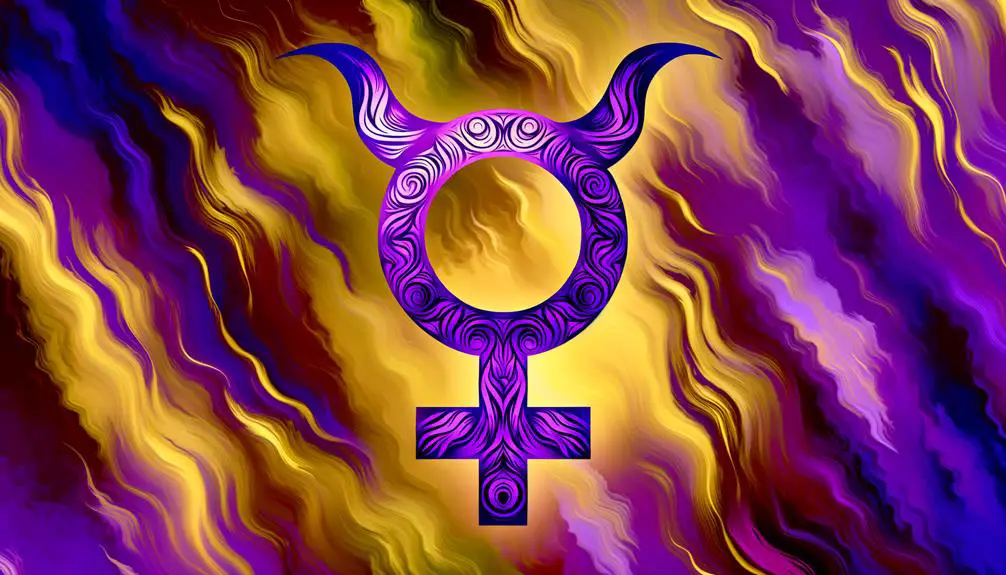
The female symbol with horns has been interpreted by many feminists as a potent emblem of female empowerment and resistance against patriarchal norms. This symbol, often merging classical femininity with elements of strength and defiance, challenges traditional gender roles.
Feminist theorists argue that the horns represent a reclamation of power historically denied to women, subverting the stereotype of passivity. Contextually, this emblem evokes the mythological figures like goddesses and female warriors, who embodied both nurturing and ferocity.
Narratively, it acts as a visual manifesto, urging women to embrace multifaceted identities. By intertwining traditional and rebellious imagery, the female symbol with horns encapsulates the ongoing feminist struggle for equality and self-determination in a visually compelling manner.
Modern Pop Culture
Building on its feminist roots, the female symbol with horns has permeated modern pop culture, manifesting in various mediums such as fashion, music, and visual art to continue challenging societal norms. This symbol's contemporary usage reflects a nuanced blend of empowerment and rebellion, making it a potent cultural icon.
Consider the following examples:
- Fashion: Designers incorporate the symbol into bold, avant-garde collections, signifying strength and independence.
- Music: Artists use it in album art and performances to convey themes of defiance and self-expression.
- Visual Art: Contemporary artists employ the symbol to critique traditional gender roles and explore identity.
These manifestations highlight the symbol's enduring relevance and its capacity to provoke thought and inspire change.
Psychological Insights
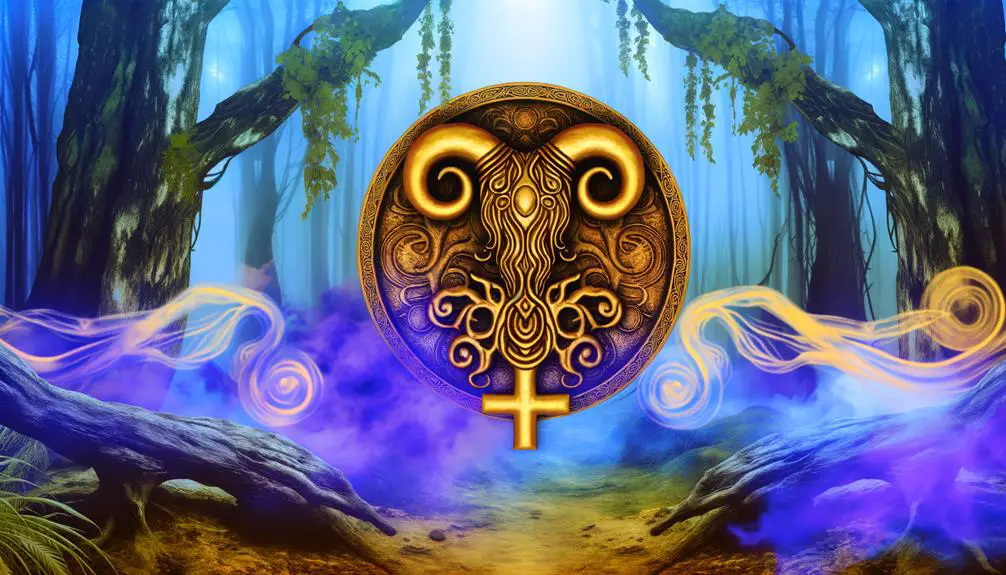
In examining the psychological implications of the female symbol with horns, it becomes evident that this imagery intersects deeply with modern understandings of symbolism and archetypes.
From a psychological perspective, such symbols can challenge and reframe traditional gender dynamics, offering a potent narrative for empowerment and complexity in female identity.
Symbolism in Modern Psychology
Modern psychology interprets the female symbol with horns as a multifaceted icon, often representing the duality of human nature and the complexity of feminine identity. This symbol encapsulates several psychological dimensions that resonate deeply within contemporary discourse.
- Ambivalence: It underscores the coexistence of contrasting emotions and traits within an individual, highlighting the human capacity for both nurturing and assertiveness.
- Empowerment: The horns signify strength and dominance, challenging traditional notions of passive femininity.
- Integration: It emphasizes the importance of reconciling different aspects of the self, fostering psychological wholeness.
Archetypes and Gender Dynamics
Examining the female symbol with horns through the lens of archetypes and gender dynamics reveals deeper psychological insights into how these symbols shape and reflect societal perceptions of femininity and power.
Archetypally, horns often symbolize strength, authority, and divinity. When combined with female imagery, this creates a powerful juxtaposition that challenges traditional gender roles.
This symbol can evoke the notion of the 'warrior goddess,' merging nurturing aspects with assertive, protective qualities. It reflects evolving views on gender, where femininity encompasses a broader spectrum including leadership and resilience.
Such symbols are instrumental in breaking down monolithic gender constructs, offering a more nuanced understanding of the interplay between identity, power, and societal expectations.
Global Variations
Across different cultures, the female symbol with horns takes on unique interpretations that reflect varying mythological, religious, and social contexts. In ancient Egyptian mythology, the goddess Hathor is depicted with cow horns, symbolizing fertility and motherhood.
Meanwhile, in Greek mythology, the goddess Hera is often shown with horns, representing her role as the protector of women and marriage. In modern Wiccan traditions, the horned female symbolizes the duality of nature and the balance between masculine and feminine energies.
These variations highlight the richness of cultural interpretations.
Conclusion
In sum, the female symbol with horns, an icon of unparalleled complexity, traverses historical epochs, mythological narratives, and diverse cultural landscapes.
Its representation in art and modern pop culture further accentuates its multifaceted nature, while feminist perspectives imbue it with contemporary significance.
Psychological insights and global variations add layers to its interpretation, making it a subject of inexhaustible academic inquiry.
This symbol, imbued with rich historical and cultural context, remains a demonstration of the inexhaustible depth of human symbolism.





